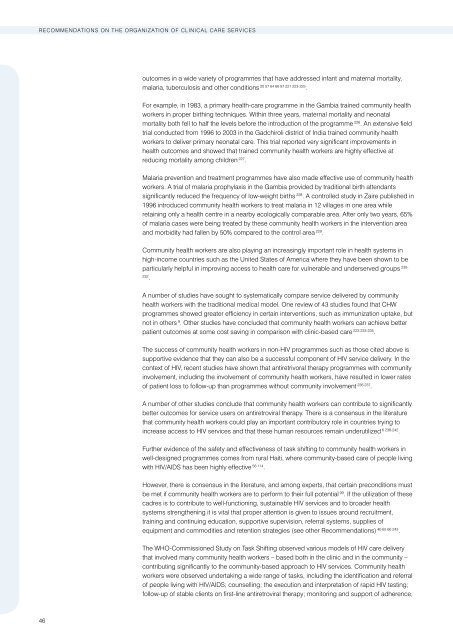Task Shifting - Global Recommendations and Guidelines - unaids
Task Shifting - Global Recommendations and Guidelines - unaids
Task Shifting - Global Recommendations and Guidelines - unaids
You also want an ePaper? Increase the reach of your titles
YUMPU automatically turns print PDFs into web optimized ePapers that Google loves.
<strong>Recommendations</strong> on the organization of clinical care services<br />
outcomes in a wide variety of programmes that have addressed infant <strong>and</strong> maternal mortality,<br />
malaria, tuberculosis <strong>and</strong> other conditions 20 57 64 66 97 221 223-225 .<br />
For example, in 1983, a primary health-care programme in the Gambia trained community health<br />
workers in proper birthing techniques. Within three years, maternal mortality <strong>and</strong> neonatal<br />
mortality both fell to half the levels before the introduction of the programme 226 . An extensive field<br />
trial conducted from 1996 to 2003 in the Gadchiroli district of India trained community health<br />
workers to deliver primary neonatal care. This trial reported very significant improvements in<br />
health outcomes <strong>and</strong> showed that trained community health workers are highly effective at<br />
reducing mortality among children 227 .<br />
Malaria prevention <strong>and</strong> treatment programmes have also made effective use of community health<br />
workers. A trial of malaria prophylaxis in the Gambia provided by traditional birth attendants<br />
significantly reduced the frequency of low-weight births 228 . A controlled study in Zaire published in<br />
1996 introduced community health workers to treat malaria in 12 villages in one area while<br />
retaining only a health centre in a nearby ecologically comparable area. After only two years, 65%<br />
of malaria cases were being treated by these community health workers in the intervention area<br />
<strong>and</strong> morbidity had fallen by 50% compared to the control area 229 .<br />
Community health workers are also playing an increasingly important role in health systems in<br />
high-income countries such as the United States of America where they have been shown to be<br />
particularly helpful in improving access to health care for vulnerable <strong>and</strong> underserved groups 230-<br />
232<br />
.<br />
A number of studies have sought to systematically compare service delivered by community<br />
health workers with the traditional medical model. One review of 43 studies found that CHW<br />
programmes showed greater efficiency in certain interventions, such as immunization uptake, but<br />
not in others 9 . Other studies have concluded that community health workers can achieve better<br />
patient outcomes at some cost saving in comparison with clinic-based care 223 233-235 .<br />
The success of community health workers in non-HIV programmes such as those cited above is<br />
supportive evidence that they can also be a successful component of HIV service delivery. In the<br />
context of HIV, recent studies have shown that antiretrivoral therapy programmes with community<br />
involvement, including the involvement of community health workers, have resulted in lower rates<br />
of patient loss to follow-up than programmes without community involvement 236 237 .<br />
A number of other studies conclude that community health workers can contribute to significantly<br />
better outcomes for service users on antiretroviral therapy. There is a consensus in the literature<br />
that community health workers could play an important contributory role in countries trying to<br />
increase access to HIV services <strong>and</strong> that these human resources remain underutilized 6 238-242 .<br />
Further evidence of the safety <strong>and</strong> effectiveness of task shifting to community health workers in<br />
well-designed programmes comes from rural Haiti, where community-based care of people living<br />
with HIV/AIDS has been highly effective 56 114 .<br />
However, there is consensus in the literature, <strong>and</strong> among experts, that certain preconditions must<br />
be met if community health workers are to perform to their full potential 99 . If the utilization of these<br />
cadres is to contribute to well-functioning, sustainable HIV services <strong>and</strong> to broader health<br />
systems strengthening it is vital that proper attention is given to issues around recruitment,<br />
training <strong>and</strong> continuing education, supportive supervision, referral systems, supplies of<br />
equipment <strong>and</strong> commodities <strong>and</strong> retention strategies (see other <strong>Recommendations</strong>) 40 65 66 243 .<br />
The WHO-Commissioned Study on <strong>Task</strong> <strong>Shifting</strong> observed various models of HIV care delivery<br />
that involved many community health workers – based both in the clinic <strong>and</strong> in the community –<br />
contributing significantly to the community-based approach to HIV services. Community health<br />
workers were observed undertaking a wide range of tasks, including the identification <strong>and</strong> referral<br />
of people living with HIV/AIDS; counselling; the execution <strong>and</strong> interpretation of rapid HIV testing;<br />
follow-up of stable clients on first-line antiretroviral therapy; monitoring <strong>and</strong> support of adherence;<br />
46

















